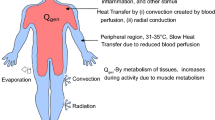Abstract
Experiments were performed on 9 volunteers in which the changes in rectal temperature and sweat rate were recorded under different levels of metabolic rate (100, 306 and 560 kcal/hr), air temperatures (30° and 40°C), vapor pressure (15, 22 and 31 mm Hg) and air velocity (50, 200 and 400 cm/sec).Analysis of the results enabled the development of a formula for the prediction of the elevation of body(rectal) temperature after 30 min of work at known metabolic rates in given thermal environments. The elevation in body temperature is considered to express both the amount of heat dissipated through the heat dissipating mechanism,as well as the heat which has not been dissipated and is stored in the body.With the aid of the proposed formula, the permissible metabolic rate of work at various external heat loads can be calculated.
Zusammenfassung
An neun Versuchspersonen wurden Versuche vorgenommen,bei denen die Änderungen der Rektaltemperatur und Schweissabsonderung bei verschiedenen Werten des Stoffwechsels (100, 306 und 560 kcal/h), der Lufttemperatur (30° und 40°C),des Dampfdrucks (15, 22 und 31 mm Hg) und der Windgeschwindigkeit (50, 200 und 400 cm/sec) untersucht wurden. Die Bearbeitung der Ergebnisse erlaubte die Entwicklung einer Formel für die Vorhersage der Erhöhung der (rektalen) Körpertemperatur nach einer Arbeit von 30 Min Dauer bei bekannten Stoffwechselwerten und vorgegebener thermischer Umgebung. Die Erhöhung der Körpertemperatur wird als Ausdruck sowohl für den Betrag der Wärme betrachtet, die durch den Mechanismus der Wärmeabgabe abgegeben wird, wie für die Wärme, die nicht abgegeben,sondern im Körper gespeichert wird.Mit Hilfe der vorgeschlagenen Formel kann die erlaubte Stoffwechselrate der Arbeit unter verschiedenen äusseren Wärmebelastungen berechnet werden.
Resume
Neuf personnes ont servi à des essais tendant à démontrer que la température rectale et la sécrétion de sueur dépendent de différents facteurs.Ces derniers furent: le métabolisme général (100, 306 et 560 kcal/h),la température de l'air (30° et 40°C), la pression de vapeur (15, 22 et 31 mm Hg) et la vitesse du vent (50, 200 et 400 cm/sec). La compilation des résultats a permis de mettre au point une formule par le truchement de laquelle il est possible de calculer à l'avance la hausse de la température rectale après un travail de 30 min,lorsque l'on connaît l'indice de métabolisme et les conditions thermiques du milieu ambiant. La hausse de la température de corps est l'expression aussi bien de la chaleur perdue par les mécanismes de thermorégulation que de la chaleur qui est emmagasinée par le corps. Par la formule proposée, on peut aussi calculer l'indice de métabolisme tolérable lors d'un travail exécuté dans des conditions thermiques déterminées.
Similar content being viewed by others
References
BEDFORD, T. (1936): The Warmth Factor in Comfort at Work. Industrial Health Research Board Report No. 76. H.M.S.O. London.
BELDING, H.S. and HATCH, T.F. (1955): Index of evaluating heat stress in terms of resulting physiological strain. Heat. Pip. Air Condit., 27: 129–136.
GILAT, T., SHIBOLET, S. and SOHAR, E. (1963): The mechanism of heatstroke. J. Trop. Med. Hyg., 66: 204–212.
GIVONI, B. (1962): The influence of work and environmental conditions on thephysiological responses and thermal equilibrium of man. Arid Zone Research (Unesco), 24: 199–204.
GIVONI, B. (1963): Estimation of the effect of climate on man: Development of a new thermal index. Research Report,Building Research Station, Technion, Haifa, Israel, pp. 138.
HOUGHTEN, F.C. and Yagloglou, C.P. (1923): Determining lines of equal comfort.Amer. Soc.Heat.Vent.Eng. Trans., 29: 163–175.
McARDEL, B., DUNHAM, W., HOLLING, H.E., LADELL, W.S.S., SCOTT, J.W., THOMSON, M. L. and WEINER, J.S. (1947): The prediction of the physiological effect of warm and hot environments. Med.Res.Council R.N.P. 47/391.H.S.194/London.
MISSENARD, H. (1948): Equivalences thermiques de ambience;equivalences de passage; equivalence de sejour.Chaleur et Industrie,24:159–183.
ROBINSON, S., TURRELLI, E.S. and GERKING, S.D. (1945): Physiologically equivalent conditions of air temperature and humidity.Amer.J.Physiol., 143: 21–32.
SOHAR, E., GILAT, T., ADAR, R., KALI, J., YASKI, D. and GIVONI, B. (1962): The effect of physical effort and external heat load on body temperature. Harefuah, 63: 6–9.
WINSLOW, C.E.A., HEMINGTON, L.P. and GAGGE, A.P. (1937): Physiological reactions of human body to varying environmental temperatures.Amer.J. Physiol., 120: 1–22.
Author information
Authors and Affiliations
Additional information
This work was supported in part by grant NS/1488/62 of UNESCO and in part by grant C-1/Ford 4, of the Ford Foundation.
Rights and permissions
About this article
Cite this article
Givoni, B., Sohar, E. Rectal temperature in the prediction of permissible work rates in hot environments. Int J Biometeorol 12, 41–50 (1968). https://doi.org/10.1007/BF01552977
Received:
Issue Date:
DOI: https://doi.org/10.1007/BF01552977




